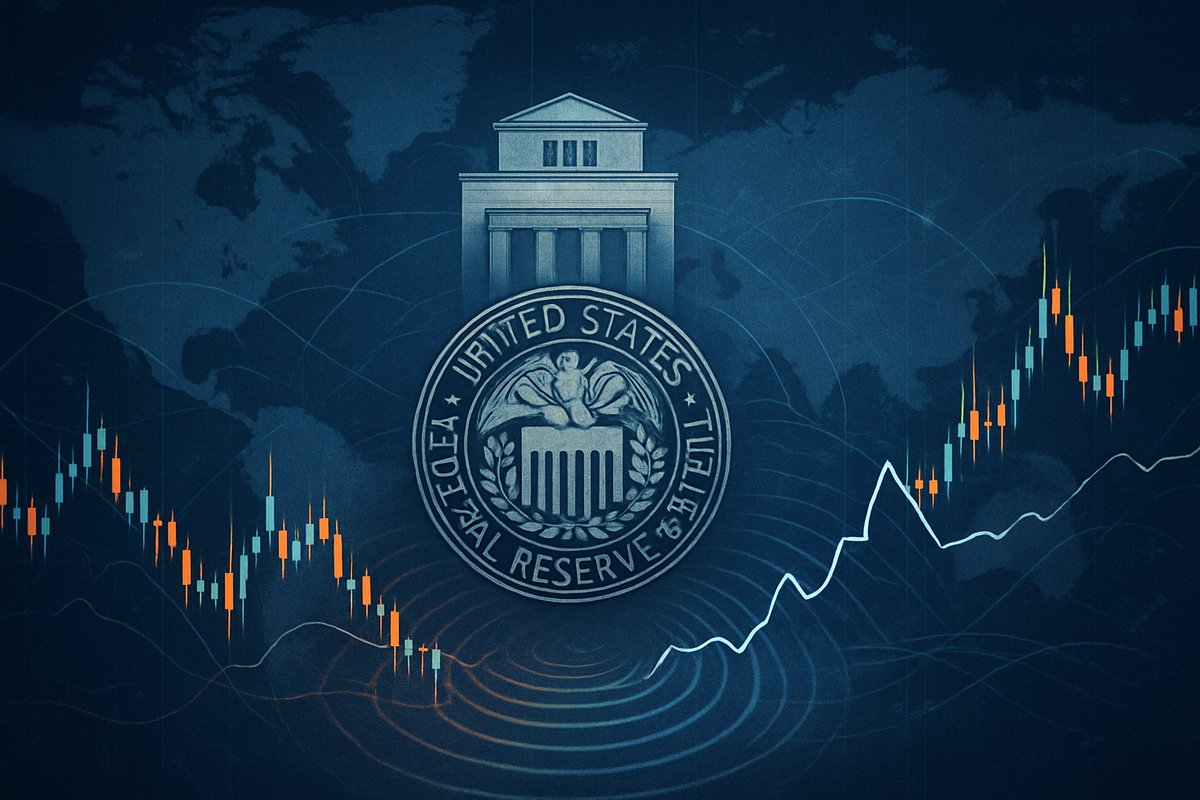
Federal Reserve Chair Jerome Powell delivered a highly anticipated keynote speech today, October 14, 2025, on "Economic Outlook and Monetary Policy" at the National Association for Business Economics (NABE) Annual Meeting in Philadelphia. This address, his first major public appearance since the September Federal Open Market Committee (FOMC) meeting, comes at a critical juncture for financial markets. Investors were keenly awaiting Powell's remarks for clarity on the Fed's policy path, especially concerning future interest rate adjustments, inflation, and the implications of a softening labor market and ongoing trade tensions.
The market's immediate reaction to Powell's speech is expected to be significant, influencing sentiment across various asset classes. With futures markets already pricing in a high probability (around 97%) of a 25 basis point rate cut at the upcoming October 28-29 FOMC meeting, Powell's tone—whether dovish or hawkish—is crucial. A dovish stance, signaling further easing, could reassure markets and potentially boost risk assets, while a more hawkish tone could exacerbate fears of an economic slowdown and trigger increased volatility, particularly given recent concerns about US-China trade tensions and new tariffs.
Detailed Coverage: Powell's Stance and the Road to Easing
Chair Powell's address today, scheduled between 11:30 AM and 1:10 PM ET, focused on providing crucial guidance amidst a complex economic landscape. His commentary was expected to delve into the implications of a recent U.S. government shutdown, which has delayed key economic data releases, and signs of a moderating labor market. Key areas of discussion included the Fed's monetary policy stance, his assessment of current economic conditions characterized by stronger-than-expected growth alongside tariff impacts, inflationary pressures (with July's total Personal Consumption Expenditures (PCE) inflation at 2.6% and core PCE at 2.9%), and the dynamics of a decelerating job market.
The timeline leading up to this moment underscores the Fed's evolving approach. In August 2025, Powell's speech at the Jackson Hole Economic Symposium hinted at potential policy adjustments, interpreted as dovish. This was followed by the September 16-17 FOMC meeting, which resulted in a quarter-point rate cut, bringing the federal funds target range to 4.00%-4.25%. This meeting, however, revealed divisions among Fed officials regarding the future path of rate cuts. Economic forecasts for Q3 2025 generally anticipate below-potential U.S. real GDP growth (around 1.7% for the year) and elevated core consumer price inflation. The ongoing government shutdown has further complicated the assessment by delaying critical data like the September jobs report.
Key players involved in this unfolding narrative include Jerome Powell himself, who is delivering the keynote. Emily Kolinski Morris, CBE, NABE President and Chief Economist at Ford Motor Company (NYSE: F), is moderating the session. Other Federal Reserve Governors, Michelle Bowman and Christopher Waller, are also scheduled to speak today, offering additional perspectives that will be scrutinized by markets. Initial market reactions, even prior to the full digestion of Powell's remarks, show volatility, with cryptocurrencies like Bitcoin and Ethereum experiencing declines as traders awaited definitive guidance. Investors are also wary of Powell's previous warnings about "fairly highly valued" equity prices.
Company Impact: Winners and Losers in a Lower-Rate Environment
The anticipated Federal Reserve interest rate cut at the October 28-29 FOMC meeting, following Powell's dovish signals, is poised to create distinct winners and losers across various public companies and sectors. A rate cut generally reduces borrowing costs, stimulates consumer spending, and can boost valuations for companies with long-term earnings potential.
Potential "Winners" from this easing cycle include Growth Stocks, particularly in the Technology sector, such as Microsoft (NASDAQ: MSFT) and Apple (NASDAQ: AAPL), and Small-Cap companies. These firms often rely on external funding for expansion, and lower rates reduce their cost of capital while increasing the present value of their future profits. High-growth areas like AI infrastructure are expected to see significant gains. Consumer Discretionary companies, including Crocs (NASDAQ: CROX) and Royal Caribbean Cruises (NYSE: RCL), also stand to benefit as lower borrowing costs encourage consumer spending on non-essential goods and services.
The Housing and Real Estate sectors, encompassing homebuilders like D.R. Horton (NYSE: DHI) and Lennar Corporation (NYSE: LEN), along with Real Estate Investment Trusts (REITs), are highly sensitive to interest rates. Lower mortgage rates make homeownership more affordable, stimulating demand and benefiting companies involved in construction and home improvement, such as Caterpillar (NYSE: CAT). Utilities companies, being capital-intensive and debt-heavy, will see reduced borrowing costs for infrastructure upgrades, improving their margins. Stable dividends offered by utilities like NiSource Inc. (NYSE: NI) become more attractive when fixed-income yields decline.
Conversely, Financial Institutions, particularly traditional banks like JPMorgan Chase (NYSE: JPM) and Bank of America (NYSE: BAC), may face headwinds. While lower rates can stimulate lending demand, they typically compress net interest margins (NIMs)—the difference between what banks earn on loans and what they pay on deposits—potentially reducing profitability. Insurance companies may also see reduced returns on their bond investments. However, some financial institutions, especially investment banks, might benefit from increased capital market activity spurred by cheaper borrowing.
Wider Significance: A Global Monetary Shift
The Federal Reserve's anticipated rate cut, underscored by Powell's speech, signifies a broader global monetary shift. This event fits into a trend where central banks are increasingly prioritizing economic growth and employment stability, even if it means tolerating slightly elevated inflation. The Fed's actions send a strong signal to other central banks, potentially influencing their own monetary policy decisions to manage exchange rates and capital flows.
The ripple effects are extensive. For highly leveraged businesses, competitors, and partners, lower borrowing costs could fuel investment, expansion, and even increased merger and acquisition (M&A) activity. A potentially weaker U.S. dollar, a common outcome of rate cuts, would make American exports more competitive internationally, benefiting U.S. exporters and creating challenges for foreign competitors. Conversely, companies relying heavily on imports might face higher costs. In the financial sector, banks will need to adjust their lending strategies, while fintech partners might find new opportunities in a lower-rate environment.
Regulatory and policy implications are also significant. Regulators might increase scrutiny of lending standards to prevent excessive risk-taking in a low-rate environment. The Fed's actions could also influence fiscal policy discussions, with some potentially arguing for complementary government spending or tax cuts to further stimulate the economy. Historically, periods of aggressive rate cuts, such as those following the dot-com bust in the early 2000s or the 2008 financial crisis, have aimed to cushion economic downturns or provide stimulus. While effective in stabilizing economies, they have also, at times, contributed to asset bubbles or other imbalances, highlighting the delicate balance the Fed must maintain.
What Comes Next: Navigating an Evolving Landscape
Following Powell's speech and the anticipated rate cut, the market is poised for a dynamic period. In the short-term, equity markets are generally expected to perform well, with growth stocks and small-caps leading the charge due to reduced borrowing costs and improved investor sentiment. Bond prices may rise as yields fall, though longer-term yields could see some upward pressure if inflation expectations increase. The U.S. dollar is likely to weaken, providing a tailwind for international equities and emerging markets, while commodities like gold may benefit from lower opportunity costs.
In the long-term, the possibilities are more nuanced. If the rate cuts successfully stimulate borrowing and investment without reigniting inflation, they could usher in a period of sustained economic growth. However, overly aggressive cuts could lead to inflationary pressures or even asset bubbles. Strategic pivots for businesses will be crucial, including leveraging cheaper financing for capital expenditures, refinancing existing debt, and adjusting cash management strategies. Companies in consumer discretionary, technology, and real estate sectors should capitalize on increased demand and lower borrowing costs, while financial institutions will need to carefully manage compressed net interest margins.
Potential market opportunities include increased M&A activity, particularly in growth sectors, and a stronger appeal for international markets and precious metals. Challenges include the persistent risk of inflation, potential credit quality concerns for banks, and lower returns for savers. Analysts generally anticipate a "soft landing" scenario, where rate cuts facilitate a stable, moderate growth period, with equities performing well. However, investors must also consider scenarios of inflationary resurgence or a recessionary easing, each with distinct market implications.
Comprehensive Wrap-up: A Cautious Path Forward
Fed Chief Powell's October 14, 2025 speech reinforced the Federal Reserve's commitment to a dovish monetary policy, signaling a continued rate-cutting cycle into late 2025 and 2026. Key takeaways include the Fed's focus on supporting a softening labor market, managing inflation exacerbated by tariffs, and Powell's cautionary remarks on "fairly highly valued" equity markets. The ongoing government shutdown further complicates the Fed's decision-making by delaying crucial economic data.
Moving forward, the market is likely to see continued volatility amidst this accommodating monetary environment. The dovish stance is generally supportive of global equities and bonds, but geopolitical risks, trade tensions, and the high valuation of the S&P 500 suggest potential for corrections. Capital flows are expected to redirect towards higher-yielding emerging markets, and commodity prices, particularly gold and silver, may continue their ascent. Sectoral performance will likely favor technology, communication services, and cyclical sectors as growth potentially re-accelerates.
The lasting impact of this easing cycle will hinge on the Fed's ability to achieve a "soft landing"—taming inflation without triggering a severe recession, all while navigating external shocks. Investors should remain vigilant and adopt a cautious yet strategic approach. In the coming months, it is imperative to closely monitor Fed communications, especially the upcoming FOMC meeting on October 28-29, 2025, and keenly watch for updates on labor market indicators and inflation data once available. Re-evaluating portfolio risk, considering diversification into alternative assets like precious metals, and being prepared for market swings will be crucial for navigating the evolving financial landscape.
This content is intended for informational purposes only and is not financial advice





